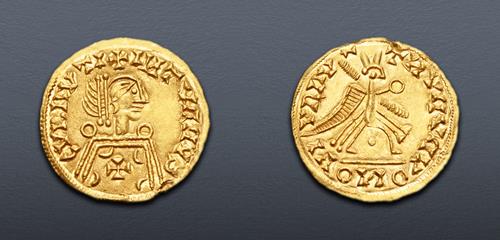
|
VISIGOTHS, Spain. ‘Curru’ Group. Circa 568-592. AV Tremissis (19mm, 1.23 g, 6h). Toleto (Toledo) mint.
Triton XXV
Lot: 1085. Estimated: $ 1 500
Early Medieval & Islamic, Coin-in-Hand Video, Gold
Sold For $ 3 000. This amount does not include the buyer’s fee.
Go to Live
|
|
VISIGOTHS, Spain. ‘Curru’ Group. Circa 568-592. AV Tremissis (19mm, 1.23 g, 6h). Toleto (Toledo) mint. CVRRVTI + IИTV(retrograde R)(retrograde R)V(retrograde C), diademed and draped bust right; cross on drapery with crescents above and below / VI VRRV – TИV V(retrograde R)V(retrograde R)V, Victory advancing right, holding wreath and palm frond; OИO. Tomasini Group C3, 583 var. (legends); cf. Chaves 80 (for type); cf. MEC 1, 207 (same); ME –; Triton XX, lot 1098 (same obv. die). Areas of light toning, tiny scrape on reverse edge. EF.
From the Rossini Collection. Ex Cayón (11 December 2006), lot 1021.
From the collector:
Visigothic coins, circulating in Spain between the 5th and early 8th centuries form an intriguing series, not least so for their unusual and distinctive artistic style. While the coins issued by the first Visigothic kings resemble similar issues produced by contemporary Germanic tribes, and the coinage of the 5th to the 6th century issues were heavily influenced by Romano-Byzantine imitative types, it is the coins of the later Visigothic kings which exhibit the intriguing abstract characteristics that make them stand out from the panorama of other barbarous coin types circulating in the early Middle Ages.
This evolution towards abstract representation begins with the coin types of Recesvinto (649-672) whose coinage introduced alternative, more stylized, ways to represent the figural portraits of the king on the obverse, and sees the first notable departure from the more standard, formalized, figural types that had characterized the early series as seen in the coins of Leovigildo through to Chindasvinto (569 - 653).
However, it is the coinages of Wamba (672-680) and even more so with his successors, Ervigio (680-687), Egica (687-702), Witiza (698-710), and the joint reign issues of Egica and Witiza (695-702), that the figural evolution towards abstract models finds its most original expression. It is these distinctive types where the familiar attributes of regal power, the crown and sceptre, become intermingled with the king’s portrait in a strange combination of blurred, abstract, figural representation of great charm.
The small selection presented here aims to show some of the intriguing examples created in this quest for abstraction and reflects both the artistic and historical appeal they have for the collector who humbly assembled them.
The final winners of all Triton XXV lots will be determined at the live public sale that will be held on 11-12 January 2022. Triton XXV – Session Four – Early Medieval & Islamic Coinage through Large Lots will be held Wednesday afternoon, 12 January 2022 beginning at 2:00 PM ET.
Winning bids are subject to a 20% buyer's fee for bids placed on this website and 22.50% for all others.
We recognize that our users may have various Internet Browsers and Operating Systems. We like our visitors to have the best possible experience when using our bidding platform. However, we do recognize that it is impossible to develop applications that work identically, efficiently and effectively on all web browsers. The CNG bidding platform supports the latest stable major version and the stable previous version of Mozilla Firefox and Chrome.
|
